Contents
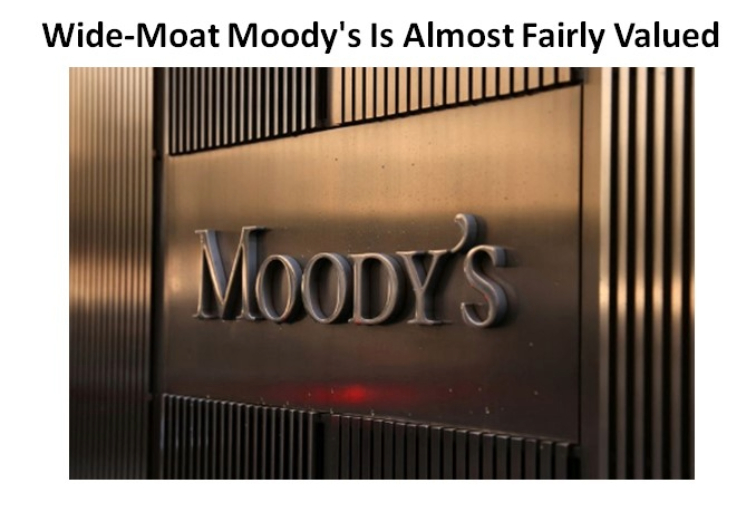
I last reviewed Moody’s (MCO) in my July 26, 2024 post at which time I considered shares to be richly valued. With the April 22 release of Q1 2025 results and revised FY2025 guidance, I revisit this existing holding.
Business Overview
Details of MCO’s operations are found in Part 1 Item 1 in the FY2024 Form 10-K which is accessible through the SEC Filings section of the company’s website.
MSCI and MCO to Launch Independent Risk Assessments for Private Credit Investments
On April 21, 2025, both companies announced that they will jointly create a first-of-its-kind solution to provide independent risk assessments for private credit investments at scale.
This partnership brings together MCO’s credit scoring models with MSCI’s very deep data on private credit investments. Together, they will:
- enable investors to understand the credit profile of companies and individual loans; and
- serve a critical need for transparency and standards in the private credit market.
Neither company has disclosed the revenue model or opportunity. The private credit market, however, is significant and growing rapidly. Based on MCO’s and MSCI’s engagement with investors – pension funds, long-only investors, and insurance companies that are big allocators to private credit – there is considerable desire to have a rigorous third-party credit assessment of the investments in which they invest.
Financials
Q1 2025 Results
Material pertaining to MCO’s Q1 2025 results is accessible here.
The following is a very high level overview of MCO’s Q1 2025 results. More granular information is provided in the financials and earnings presentation.
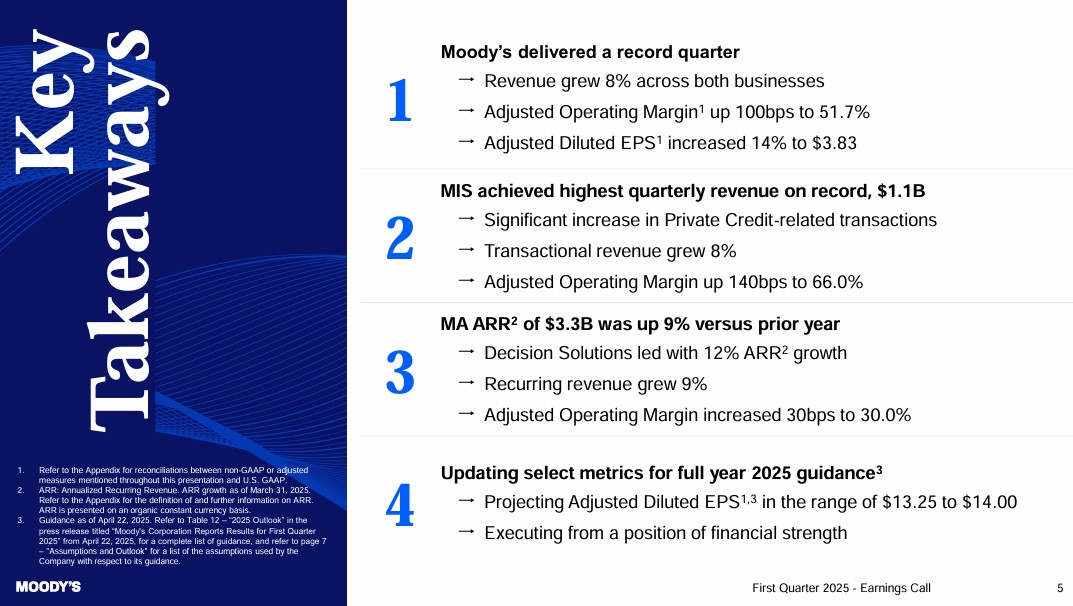
Operating Cash Flow (OCF), CAPEX, and Free Cash Flow (FCF)
Since FCF is a non-GAAP measure, there is no consistency in its calculation. In several previous posts I explain my rationale for deducting stock-based compensation (SBC) to determine a company’s FCF. I, therefore, provide calculations using the:
- conventional method where only CAPEX is deducted from OCF; and
- more conservative modified method where I also deduct SBC.
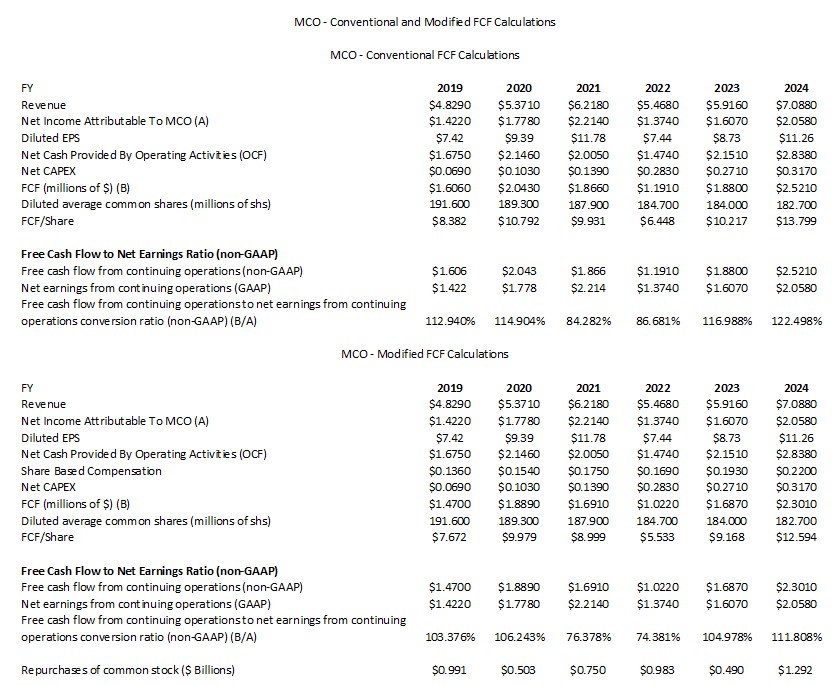
Capital Allocation
The following reflects MCO’s capital allocation in FY2023 and FY2024 and the forecast for FY2025. MCO’s Global FCF does not deduct SBC.
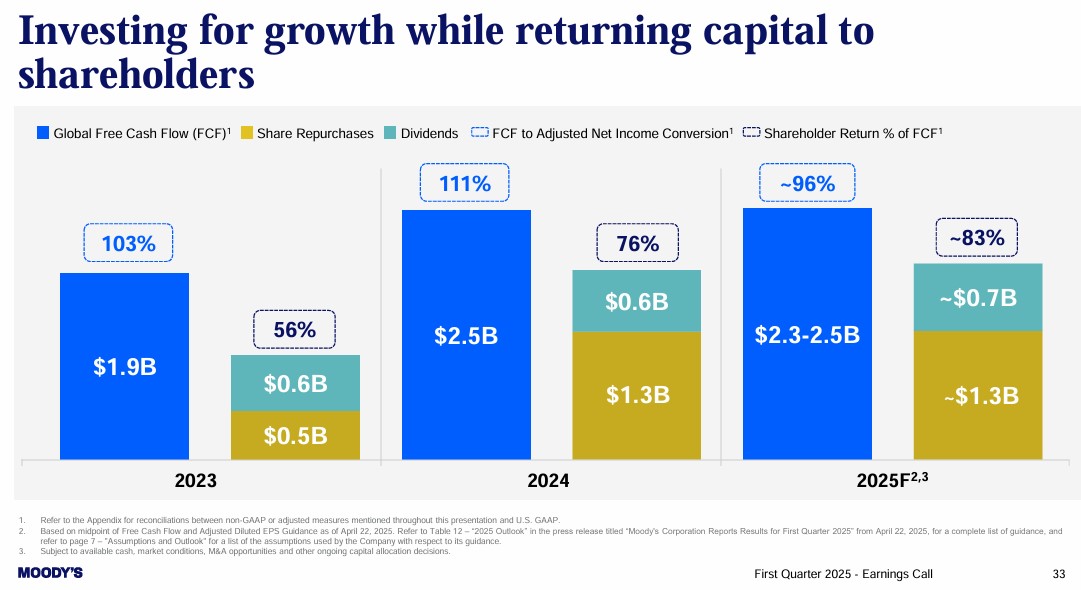
Return On Invested Capital (ROIC)
MCO’s ROIC (%) in FY2018 – FY2024 is 26.09, 24.59, 25.41, 24.48, 14.75, 17.20, and 20.31. (Source: Morningstar)
High quality companies often generate a high ROIC. If a company generates a high ROIC, it needs to invest less to achieve a certain growth rate thus reducing the need for external capital.
A company that generates $0.15/profit for every $1 invested, for example, achieves a ROIC of 15%. I consider a ~15%+ ROIC to be a reasonable minimum threshold because most of the time, a company’s cost of capital will be lower than this level.
When a company consistently generates a high ROIC over the long term and it is growing its revenue, it can reinvest a portion of its profits under favorable conditions thereby leading to a compounding effect. I would much rather invest in a growing company that can reinvest to create greater shareholder value than to invest in a company that has limited growth opportunities and thus chooses to distribute a growing dividend.
FY2025 Guidance
While MCO’s services are not directly impacted by tariffs announced to date, many businesses are being impacted by the uncertainty of impending trade tensions. This inevitably leads to customers delaying financing and investment. Given this, MCO is adopting a more conservative FY2025 guidance. It has widened and lowered guidance ranges to accommodate a broader range of potential outcomes.

Despite the near-term dynamics, MCO remains confident about the demand for its solutions. The deep currents that underpin the demand for its solutions are the:
- evolution of capital markets including private credit;
- digital transformation and automation in financial services industries;
- need to know more about with whom you are conducting business;
- financial impact of extreme weather events; and
- transformative power of generative AI and the tremendous opportunities available from proprietary data.
Risk Assessment
There is no change to MCO’s senior unsecured domestic long-term debt ratings and outlook.
- S&P Global – BBB+ with a stable outlook (last reviewed and affirmed on May 20, 2024); and
- Fitch – BBB+ with a stable outlook (last reviewed and affirmed on July 24, 2024) ;
Both are at the top of the lower medium-grade investment-grade tier. These ratings define MCO as having an ADEQUATE capacity to meet its financial commitments. However, adverse economic conditions or changing circumstances are more likely to lead to MCO having a weakened capacity to meet its financial commitments.
The following schedule of total indebtedness is found on page 33 of 93 in the Q1 2025 Form 10-Q.
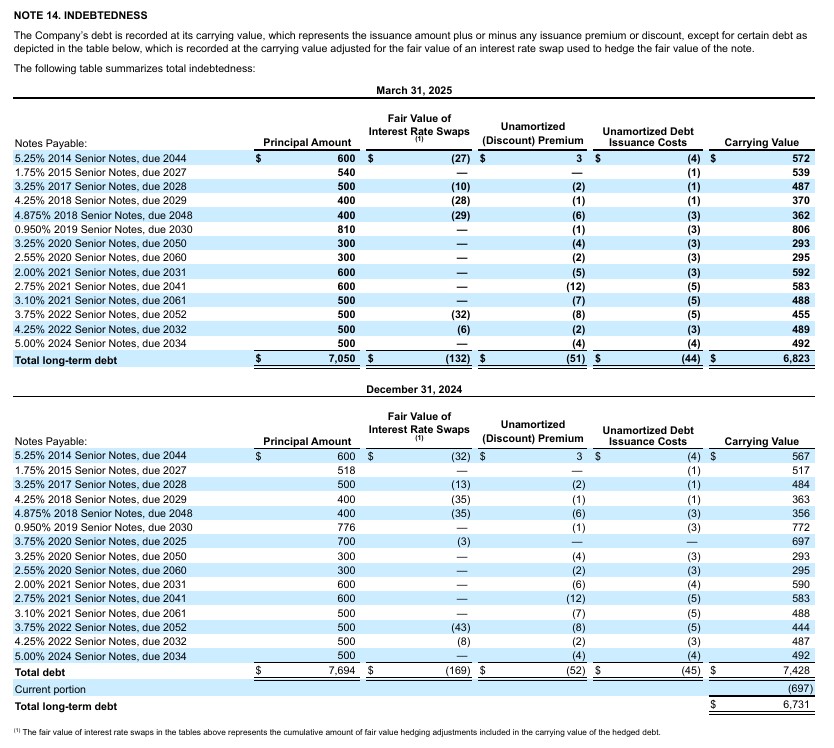
The rating assigned to each indebtedness is accessible here.
MCO’s credit risk is acceptable from my perspective.
Dividend and Dividend Yield
MCO’s dividend history reflects annual dividend increases starting in 2011 following a dividend freeze that was precipitated by challenging business conditions during The Financial Crisis.
Dividend distributions are MCO’s 3rd capital allocation priority.
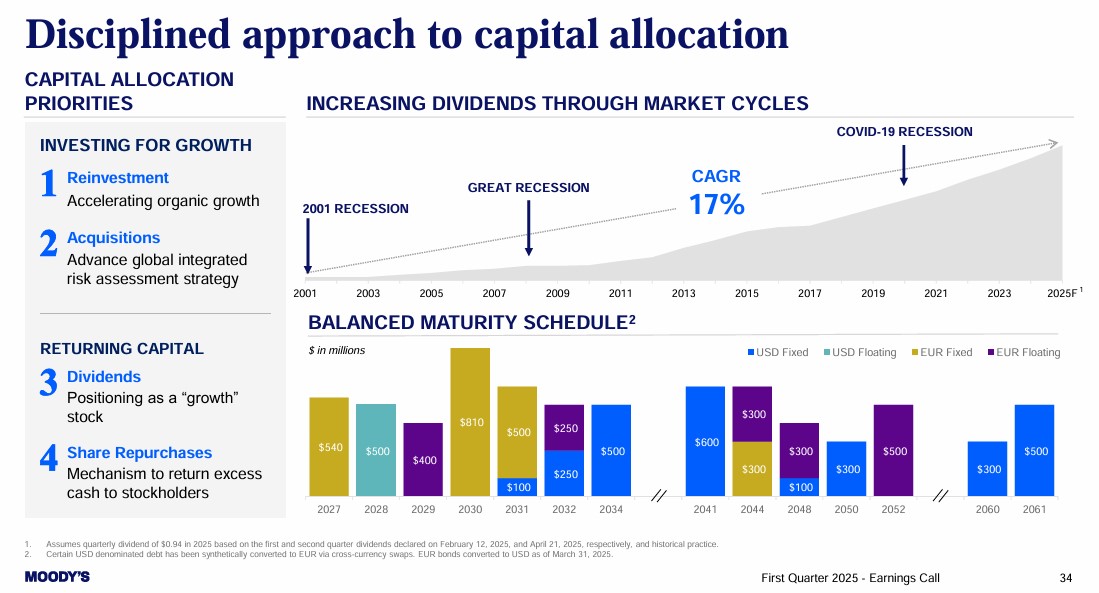
MCO is positioned as a ‘growth’ stock so the unappealing dividend metrics may dissuade some investors from investing in the company. Investors, however, should focus on an investment’s total potential return.
MCO’s diluted weighted average number of shares outstanding during FY2019 – FY2024 (in millions of shares) are reflected in the table provided earlier in this post. In Q1 2025 this had been reduced to 180.7.
The following reflects MCO’s share repurchases in Q1 2025.

Valuation
My July 26, 2024 post reflects MCO’s valuation at the various times in which I have analyzed this existing holding.
For ease of comparison, I provide my assessment of MCO’s valuation at the time of my July 26, 2024 post.
As I finalize this post on July 26, 2024, shares trade at ~$437. The forward valuations using the currently available adjusted diluted broker estimates are:
- FY2024 – 19 brokers – mean of $11.29 and low/high of $10.92 – $11.62. Using the mean estimate, the forward adjusted diluted PE is ~38.7.
- FY2025 – 20 brokers – mean of $12.80 and low/high of $11.90 – $13.90. Using the mean estimate, the forward adjusted diluted PE is ~34.
- FY2026 – 13 brokers – mean of $14.62 and low/high of $13.30 – $15.75. Using the mean estimate, the forward adjusted diluted PE is ~30.
Management’s FY2024 adjusted diluted EPS guidance is $11.00 – $11.40 thus giving us a ~38.3 – ~40 adjusted diluted PE range.
The FY2024 FCF guidance is $2B – $2.2B. If we use 183 million diluted weighted average number of shares outstanding as the average for FY2024, we get a FCF/share range of ~$11 – ~$12. Using the current ~$437 share price, we get a forward P/FCF range of ~36.4 – ~39.7.
We now know that MCO generated $12.47 of adjusted diluted EPS in FY2024. Using my July 26, 2024 ~$437 share price, MCO’s adjusted diluted PE was ~35 versus ~38.3 – ~40.
The actual FY2024 average diluted weighted average number of shares outstanding was 182.7 million versus my 183 million estimate. MCO also generated ~$13.80 and ~$12.60 of FCF/share (see table in the Operating Cash Flow (OCF), CAPEX, and Free Cash Flow (FCF) section of this post). Using my July 26, 2024 ~$437 share price, MCO’s P/FCF was closer to ~31.7 and ~34.7 calculated using conventional and modified FCF.
MCO’s April 25, 2025 closing share price was $438.62. Using management’s FY2025 diluted EPS estimate of $12.00 – $12.75, the forward diluted PE range is ~34.4 – ~36.5.
Management’s FY2025 adjusted diluted EPS estimate is $13.25 – $14.00 giving us a forward adjusted diluted PE range of ~31.3 – ~33.1.
The forward valuations using the currently available adjusted diluted broker estimates are:
- FY2025 – 22 brokers – mean of $13.71 and low/high of $13.27 – $14.26. Using the mean estimate, the forward adjusted diluted PE is ~32.
- FY2026 – 22 brokers – mean of $15.43 and low/high of $14.85 – $16.08. Using the mean estimate, the forward adjusted diluted PE is ~28.4.
- FY2027 – 11 brokers – mean of $17.43 and low/high of $16.06 – $18.85. Using the mean estimate, the forward adjusted diluted PE is ~25.2.
Management’s FY2025 FCF guidance is $2.3B – $2.5B. If we estimate $0.25B of SBC in FY2025, we get a modified FCF range of $2.05B – $2.25B.
The diluted weighted average number of outstanding shares in Q1 2025 was 180.7 million. MCO’s FY2025 forecast calls for share repurchases totaling ~$1.3B. It has already repurchased ~$0.373B in Q1 so another ~$0.927B is likely to be repurchased in Q2 – Q4. If MCO repurchases shares at an average price of $460, it will repurchase just over 2 million shares. On this basis, I estimate MCO’s FY2025 diluted weighted average number of shares outstanding will be ~179 million shares.
Using the $2.4B mid-point of management’s FCF guidance and 179 million shares, I anticipate MCO will generate ~$13.40 of FCF/share. Divide the current ~$438.62 share price by ~$13.40 and my P/FCF estimate is ~32.7.
Using the $2.15B mid-point of the modified FCF range and 179 million shares, I anticipate MCO will generate ~$12 of FCF/share. Divide the current ~$438.62 share price by ~$12 and my P/FCF estimate is ~36.6.
It is readily apparent that trying to determine a company’s valuation is difficult. Even my rudimentary calculations can generate estimates that differ considerably from actual results. If we perform discounted cash flow (DCF) calculations, our results are even more of a ‘crapshoot’ since more metrics are involved and cash flow estimates going out several years into the future are plugged into the DCF formula. In my Why I Do Not Perform Discounted Cash Flow Analyses post, I touch upon why I find this form of analysis to be a complete waste of time.
Final Thoughts
I currently hold 410 shares in a ‘Core’ account in the FFJ Portfolio; MCO was my 15th largest holding when I completed my 2024 Year End Review.
In hindsight, I should have acquired MCO shares on April 7 @ ~$400 in conjunction with the S&P Global (SPGI) shares I acquired on that date for a young investor I am helping on their journey to financial freedom. I failed to do so and, unfortunately, MCO’s share price is now $438.62 as I compose this post.
I consider ~$450 to be fair value and with shares trading at $438.62, the share price need only appreciate by ~2.6% before reaching my fair value estimate. If the share price were to retrace to ~$400, however, there is a 12% upside before reaching my ~$450 fair value estimate. I am optimistic there will be opportunities to acquire shares at more favorable valuations if I bide my time.
I wish you much success on your journey to financial freedom!
Note: Thanks for reading this article. Please send any feedback, corrections, or questions to finfreejourney@gmail.com.
Disclosure: I am long MCO.
Disclaimer: I do not know your circumstances and am not providing individualized advice or recommendations. I encourage you not to make any investment decisions without conducting your research and due diligence. You should also consult your financial advisor about your specific situation.
I wrote this article myself and it expresses my own opinions. I am not receiving compensation for it and have no business relationship with any company whose stock is mentioned in this article.

